Reports
State Framework to Address Homelessness (2016)
In August 2016, the Hawai’i Interagency Council on Homelessness adopted the State Framework, which identifies three key leverage points that are necessary to address the complex challenge of homelessness. The framework was developed after soliciting feedback from key stakeholders both inside and outside of State government. The framework sets an ambitious target of achieving ‘functional zero’ for homelessness in Hawai’i by 2020.
The framework outlines strategies to move forward in three key areas — Affordable Housing, Health and Human Services, and Public Safety. To read the full framework plan, click below:
Here are a few other documents you may find helpful:
- Framework Strategies and Tactics Chart (Rev. 2018)
- Feeback from Listening Session regarding the Hawaii State Framework (2016)
Housing First Reports (2010 to Present)
 There have been a number of reports evaluating the effectiveness of Housing First programs funded through the State of Hawai’i. The most comprehensive evaluation is of the Hawai’i Pathways Project, which can be found by clicking on the link below:
There have been a number of reports evaluating the effectiveness of Housing First programs funded through the State of Hawai’i. The most comprehensive evaluation is of the Hawai’i Pathways Project, which can be found by clicking on the link below:
In addition, the Department of Human Services submits an annual report to the Hawai’i Legislature on the status of the State Housing First program. The reports to the legislature are listed below:
- Report to the 2022 Legislature (December 2021)
- Report to the 2021 Legislature (December 2020)
- Report to the 2020 Legislature (December 2019)
- Report to the 2019 Legislature (December 2018)
- Report to the 2018 Legislature (December 2017)
- Report to the 2017 Legislature (December 2016)
- Report to the 2016 Legislature (December 2015)
- Report to the 2015 Legislature (December 2014)
- Report to the 2014 Legislature (November 2013)
- Report to the 2013 Legislature (November 2012)
- Report to the 2012 Legislature (December 2011)
- Report to the 2011 Legislature (December 2010)
Unsheltered Homelessness (2020)
 This report is prepared by the University of Hawaii at Manoa, Department of Psychology in partnership with Partners in Care, and was commissioned by the City & County of Honolulu Mayor’s Office of Housing. The goal of the report is to highlight key characteristics of unsheltered homeless individuals on Oahu who were identified in the Point in Time counts between 2017-2020, as well as the Homeless Management Information System (HMIS).
This report is prepared by the University of Hawaii at Manoa, Department of Psychology in partnership with Partners in Care, and was commissioned by the City & County of Honolulu Mayor’s Office of Housing. The goal of the report is to highlight key characteristics of unsheltered homeless individuals on Oahu who were identified in the Point in Time counts between 2017-2020, as well as the Homeless Management Information System (HMIS).
The findings suggest that the unsheltered population on Oahu is largely due to a steady influx of newly homeless individuals. The majority of unsheltered individuals (81%) were identified only in one PIT count, while 19% were identified as “repeaters” that appeared in more than one PIT count. Given the significant amounts of housing placements by service providers over this time, the data suggests that as quickly as service providers house people, new people fall into homelessness to take their place.
Based on the findings, the researchers recommended a number of service and policy suggestions, including integrating antipovery and homelessness services; providing flexible cash grants to low-income households to prevent homelessness; and extending and expanding voucher programs particularly permanent supportive housing programs. The full report can be viewed below:
Financial Modeling – Building the Case for Permanent Supportive Housing (2017)
 In 2017, the Corporation for Supportive Housing (CSH) prepared an initial report on housing projections and financial modeling to support the scaling of Permanent Supportive Housing (PSH) on the island of Oahu. The report estimated that 1,808 new units of permanent supportive housing were needed to address chronic homelessness on Oahu, and estimated an upfront cost of $278,891,232 to construct new housing or bring online additional permanent supportive housing vouchers to support this demand. The report also estimated that $38,258,508 for ongoing operating and service costs would be needed to support any new construction or vouchers. While estimated upfront costs were significant, the report also estimated that cost savings from healthcare costs alone would pay off PSH upfront costs in five years. You may view the report by clicking on the link below:
In 2017, the Corporation for Supportive Housing (CSH) prepared an initial report on housing projections and financial modeling to support the scaling of Permanent Supportive Housing (PSH) on the island of Oahu. The report estimated that 1,808 new units of permanent supportive housing were needed to address chronic homelessness on Oahu, and estimated an upfront cost of $278,891,232 to construct new housing or bring online additional permanent supportive housing vouchers to support this demand. The report also estimated that $38,258,508 for ongoing operating and service costs would be needed to support any new construction or vouchers. While estimated upfront costs were significant, the report also estimated that cost savings from healthcare costs alone would pay off PSH upfront costs in five years. You may view the report by clicking on the link below:
The Hawai’i Appleseed Center later built upon the initial report by CSH. The Hawai’i Appleseed presentation estimates that an upfront investment of $766 million in PSH over ten years will result in $2.16 billion in cost savings over that same period. The Hawai’i Appleseed presentation is found below:
Law Enforcement Assisted Diversion (2018)
 The Department of Health has funded a pilot project for Law Enforcement Assisted Diversion (LEAD) on Oahu, which launched in April 2018. The Oahu pilot is administered by the Hawai’i Health and Harm Reduction Center in partnership with a LEAD hui of 30 organizations. The initial progress report and updates regarding the Oahu LEAD pilot can be viewed below:
The Department of Health has funded a pilot project for Law Enforcement Assisted Diversion (LEAD) on Oahu, which launched in April 2018. The Oahu pilot is administered by the Hawai’i Health and Harm Reduction Center in partnership with a LEAD hui of 30 organizations. The initial progress report and updates regarding the Oahu LEAD pilot can be viewed below:
- LEAD Year Two Evaluation (October 2020)
- LEAD Year One Evaluation (October 2019)
- Honolulu’s LEAD Program Status Report (December 2018)
- LEAD Presentation to the Hawai’i Interagency Council on Homelessness (March 2018)
- LEAD Press Conference statement from Heather Lusk with The CHOW Project and Life Foundation (April 2018)
Touchpoints of Homelessness (2017)
 In 2017, as part of the Coordinated Statewide Homelessness Initiative (CSHI), Aloha United Way funded a report that researched the connections between homelessness and three overlapping institutional systems – Foster Care, Hospitals and Emergency Rooms, and the Jail and Prison System. The report is authored by Gavin Thornton, James Koshiba, and Joyce Lee-Ibarra. Recommendations from the report were shared with the Hawai’i Interagency Council on Homelessness (HICH), and the report is also publicly available on the Department of Human Services (DHS) website. The full report can be viewed below:
In 2017, as part of the Coordinated Statewide Homelessness Initiative (CSHI), Aloha United Way funded a report that researched the connections between homelessness and three overlapping institutional systems – Foster Care, Hospitals and Emergency Rooms, and the Jail and Prison System. The report is authored by Gavin Thornton, James Koshiba, and Joyce Lee-Ibarra. Recommendations from the report were shared with the Hawai’i Interagency Council on Homelessness (HICH), and the report is also publicly available on the Department of Human Services (DHS) website. The full report can be viewed below:
Homeless System Overview (2016-2017)
 Act 124, Session Laws of Hawaii 2016, required the Department of Human Services to submit a report to the 2016 and 2018 Legislature in regard to the homeless service system in Hawai’i, and plans to implement a $12,000,000 unrestricted general fund appropriation related to homeless services. The two reports are linked below:
Act 124, Session Laws of Hawaii 2016, required the Department of Human Services to submit a report to the 2016 and 2018 Legislature in regard to the homeless service system in Hawai’i, and plans to implement a $12,000,000 unrestricted general fund appropriation related to homeless services. The two reports are linked below:
Youth Experiencing Homelessness — Street Youth Study (2018)
 The University of Hawai’i Center on the Famil y, Hale Kipa, and Waikiki Health partnered together to conduct a comprehensive survey of 151 youth, ages 12-24, who identified as runaways or were experiencing homelessness. The data provided by the youth is a snapshot of Oahu’s homeless and unaccompanied youth and aims to further understanding of the experiences and service needs of this population. The full report is provided below:
The University of Hawai’i Center on the Famil y, Hale Kipa, and Waikiki Health partnered together to conduct a comprehensive survey of 151 youth, ages 12-24, who identified as runaways or were experiencing homelessness. The data provided by the youth is a snapshot of Oahu’s homeless and unaccompanied youth and aims to further understanding of the experiences and service needs of this population. The full report is provided below:
Family Assessment Center: A Case Study (2017)
 In September 2017, the Department of Human Services presented a case study on its experience with the Family Assessment Center in Kakaako, Hawai’i. The case study was shared with the National Governors Association and the 2017 Human Services Policy Advisory Institute. The presentation was made by staff of DHS and Catholic Charities Hawai’i. Click on the link below to view the presentation:
In September 2017, the Department of Human Services presented a case study on its experience with the Family Assessment Center in Kakaako, Hawai’i. The case study was shared with the National Governors Association and the 2017 Human Services Policy Advisory Institute. The presentation was made by staff of DHS and Catholic Charities Hawai’i. Click on the link below to view the presentation:
